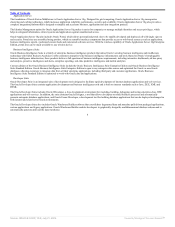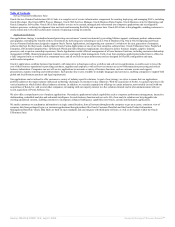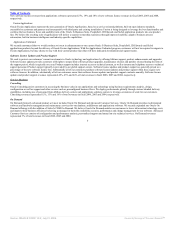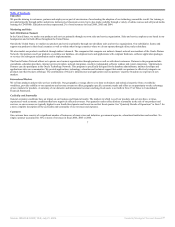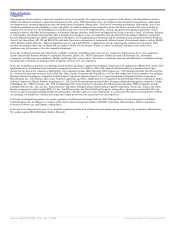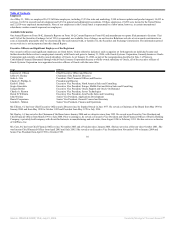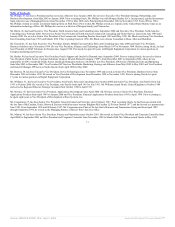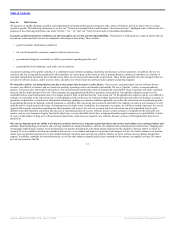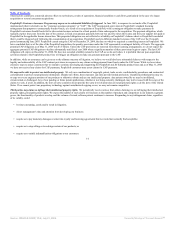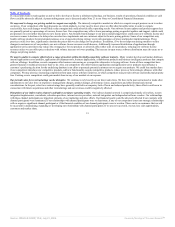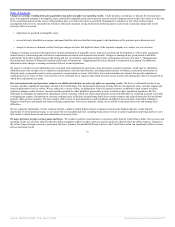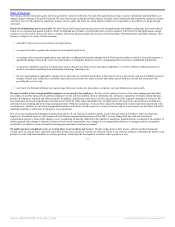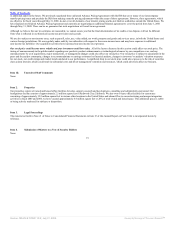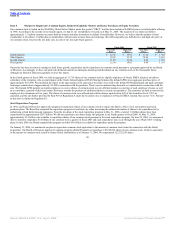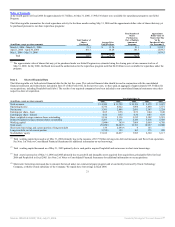Oracle 2005 Annual Report Download - page 17
Download and view the complete annual report
Please find page 17 of the 2005 Oracle annual report below. You can navigate through the pages in the report by either clicking on the pages listed below, or by using the keyword search tool below to find specific information within the annual report.
Table of Contents
These factors could have a material adverse effect on our business, results of operations, financial condition or cash flows, particularly in the case of a larger
acquisition or several concurrent acquisitions.
PeopleSoft’s Customer Assurance Program may expose us to substantial liabilities if triggered. In June 2003, in response to our tender offer, PeopleSoft
implemented what it referred to as the “customer assurance program” or “CAP”. The CAP incorporated a provision in PeopleSoft’s standard licensing
arrangement that purports to contractually burden Oracle, as a result of its acquisition of PeopleSoft, with a contingent obligation to make payments to
PeopleSoft customers should Oracle fail to take certain business actions for a fixed period of time subsequent to the acquisition. The payment obligation, which
typically expires four years from the date of the contract, is fixed at an amount generally between two and five times the license and first year support fees paid to
PeopleSoft in the applicable license transaction. This purported obligation was not reflected as a liability on PeopleSoft’s balance sheet as PeopleSoft concluded
that it could be triggered only following the consummation of an acquisition. PeopleSoft used six different standard versions of the CAP over the 18-month
period commencing June 2003. PeopleSoft ceased using the CAP on December 29, 2004, the date on which we acquired a controlling interest in PeopleSoft. We
have concluded that, as of the date of the PeopleSoft acquisition, the penalty provisions under the CAP represented a contingent liability of Oracle. The aggregate
potential CAP obligation as of May 31, 2006 was $3.5 billion. Unless the CAP provisions are removed from these licensing arrangements, we do not expect the
aggregate potential CAP obligation to decline substantially until fiscal year 2008 when a significant number of these provisions begin to expire. The last CAP
obligation will expire on December 31, 2008. We have not recorded a liability related to the CAP, as we do not believe it is probable that our post-acquisition
activities related to the PeopleSoft product line will trigger an obligation to make any payment pursuant to the CAP.
In addition, while no assurance can be given as to the ultimate outcome of litigation, we believe we would also have substantial defenses with respect to the
legality and enforceability of the CAP contract provisions in response to any claims seeking payment from Oracle under the CAP terms. While we have taken
extensive steps to assure customers that we intend to continue developing and supporting the PeopleSoft and JD Edwards product lines and as of May 31, 2006
we have not received any claims for CAP payments, PeopleSoft customers may assert claims for CAP payments.
We may not be able to protect our intellectual property. We rely on a combination of copyright, patent, trade secrets, confidentiality procedures and contractual
commitments to protect our proprietary information. Despite our efforts, these measures can only provide limited protection. Unauthorized third parties may try
to copy or reverse engineer portions of our products or otherwise obtain and use our intellectual property. Any patents owned by us may be invalidated,
circumvented or challenged. Any of our pending or future patent applications, whether or not being currently challenged, may not be issued with the scope of the
claims we seek, if at all. In addition, the laws of some countries do not provide the same level of protection of our proprietary rights as do the laws of the United
States. If we cannot protect our proprietary technology against unauthorized copying or use, we may not remain competitive.
Third parties may claim we infringe their intellectual property rights. We periodically receive notices from others claiming we are infringing their intellectual
property rights, principally patent rights. We expect the number of such claims will increase as the number of products and competitors in our industry segments
grows, the functionality of products overlap, and the volume of issued software patents continues to increase. Responding to any infringement claim, regardless
of its validity, could:
• be time-consuming, costly and/or result in litigation;
• divert management’s time and attention from developing our business;
• require us to pay monetary damages or enter into royalty and licensing agreements that we would not normally find acceptable;
• require us to stop selling or to redesign certain of our products; or
• require us to satisfy indemnification obligations to our customers.
14
Source: ORACLE CORP, 10-K, July 21, 2006 Powered by Morningstar® Document Research℠


